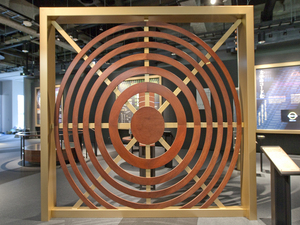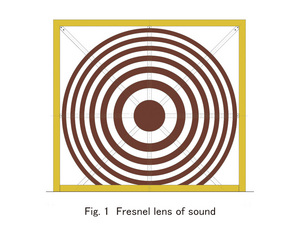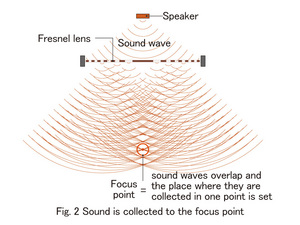Nagoya City Science Museum
TOP > Exhibition Guide > Floor Map> Fresnel Lens of Sound
Fresnel Lens of Sound



Purpose of Exhibition
You can experience the sound collected by a big board between concentric circles, and come to understand that sound can be collected because of the basic characteristics of waves [diffraction] and [interference].
Additional Knowledge
In the exhibit, sound can be gathered by skillfully using the wave characteristics of "diffraction" and "interference".
Diffraction is the phenomenon where waves cross obstacles by turning around those obstacles.
When two people stand up and talk on the opposite side of a wall with the wall between them, the sound wraps around to reach the other side of the wall; this is called "diffraction".
Interference is a phenomenon caused by multiple overlapping waves. Waves overlap each other, sometimes strengthening each other, sometimes weakening each other.
In the exhibit, there is an opening in the concentric circles, and only a portion of the sound can pass through. At that time, if only an overlapped strengthened wave passes through, the sound can be collected.
Therefore, the exhibit shows a calculated hole opened in a large board.
According to the interference-ridding method, the sound can be reduced or increased significantly.
In the case of two wave crests overlapping, the sound will become higher. In the case of crests and troughs overlapping each other, those cancel each other out, and the sound becomes lower.
In the case where they skillfully overlap, the sound disappears.
This exhibit is designed to demonstrate diffracted waves passing through a concentric cycle board from the sound source so that crests and troughs can overlap each other at an opposite point between the sound source and board. There is one rule for every crest and trough to overlap at an opposite point by passing through the several paths from the sound source.
That is, there are different paths, and the difference between all of those is the integer multiple number of sound waves. In case of a wave path, the difference is the wave length integer multiple number. Crests and crests, troughs and troughs overlap each other, and the sound becomes louder. In case of waves that are not multiples of integer numbers, especially [integer +0.5] multiple waves, the sound is negated by each other. In the concentric board portion, [integer+0.5] multiple waves are coming.
Therefore, holding a board ensures the sound does not come.
Fresnel lenses have been created by a French physicist, Augustin Jean Fresnel, and the characteristics of those lens was structurally designed to thin the thickness of lenses for the use of light houses.
Fresnel lenses are characterized by their concentric look when viewed from the front. They are used for mobile phone lenses because of their thickness.
In the exhibit, the lens has the ability to collect sound. The lens has a concentric shape, therefore, it was named the Fresnel sound lens.
The Education Society on Education of Tokyo, the committee majoring phisicsl, is a group to study educational method for physics. The members of "wave and electromagnetic" group got an idea from wave lenses in 1996, and the Fresnel lens was then developed by members of this group. Tahara Teruo, a high school teacher of the Tokyo metropolitan is the main member of this group.
Cooperation: Tahara Teruo, a high school teacher of the Tokyo metropolitanArticle by Yoshitaka Yamada, curator
